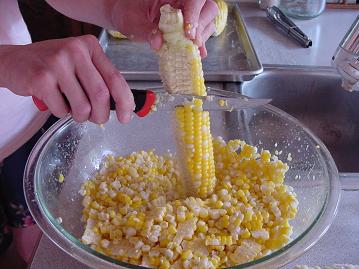Open pollinated varieties of white sweet corn started to become available in the U.S. in the 19th Century. Hybridization, which is what we see most of now, allows for more uniform maturity, improved quality and disease resistance. This is not to be confused with GMO. Do your own research between hybrid's and GMO's to gain a greater understanding of what can impact our foods.
Anyway - back to the corn. We have the opportunity to get Sweet Corn grown in Enterprise for the next few weeks. Serendipity is the sweet corn we will be receiving. Corn evokes powerful memories in me, everything from crunching down on a sweet cob of corn as a child; tasting the ice cold creaminess of brazillian milho verde (corn ice cream) to driving through the corn fields of Nebraska and being pelted by giant field bugs as they hit our wind shield. Not a pretty site --
Well, when you get tired of eating your baggies of frozen corn ... here's a few NEW recipes for you -- Corn Pudding and Corn Ice Cream ... This next recipe was revised from The Technicolor Kitchen Blog
This corn pudding is traditionally
served during the June Festival in Brazil. It's a sweet pudding
made from corn, milk, and sugar, sprinkled with cinnamon, and served cold.
Prep
Time: 20 minutes
Cook
Time: 15 minutes
Total
Time: 35 minutes
Ingredients:
- 6 ears of fresh corn
- 3 cups of milk
- 3/4 cup sugar
- pinch of salt
- 3 tablespoons butter
- cinnamon
Preparation:
- Scrape the kernels off of the ears of corn.
- Place the corn in a blender (or food processor) with the milk, and blend well, for at least 3 minutes.
- Strain the corn/milk mixture through a fine mesh sieve into a pot. Discard the fibrous parts of the kernels that remain in the sieve.
- Add the sugar, a pinch of salt, and the butter to the pot, and bring mixture to a simmer.
- Cook, stirring continuously, until the mixture becomes thick and creamy, about 15 minutes. If it's thick enough, you should be able to drag a wooden spoon across the bottom of the pot and see the bottom for several seconds before the mixture closes in on itself.
- Remove from heat and let cool. Pour pudding into a serving dish. Sprinkle with cinnamon.
- Chill thoroughly, and serve cold.
Sweet corn ice cream
1 can (200g) corn kernels, drained and rinsed (this is a scant 1 Cup Measurement of Corn Kernels, cooked on the cob first and then cut off - I have also seen this recipe done with corn "uncooked" seems like you'd get more "corn cream" if it was cooked a bit.
1 ¼ cups (300ml) whole milk
1 can (395g) sweetened condensed milk
1 cup (240ml) heavy cream
¼ teaspoon ground cinnamon
pinch of salt
Place the kernels and milk in a blender and blend until smooth. Push mixture through a sieve and put it corn "cream" back in the blender. Add the sweetened condensed milk, heavy cream, cinnamon and salt and blend.
Pour into a metal/glass bowl, cover and refrigerate for at least 2 hours, then freeze in your ice cream maker according to the manufacturer’s instructions.
Transfer ice cream to an airtight container and put in the freezer until firm, at least 4 hours, before serving.
... gotta run, looking at all this food is making me hungry!














